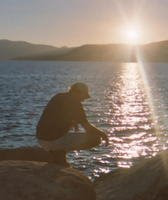 I had a couple of powerful "church" experiences in Norway that are worth sharing too. Two of my American companions were also Catholic and we decided to visit the little Catholic church in Lillehammer one Sunday morning. It was my first experiencing attending Church outside the U.S., but it revealed to me just what we mean when we call the church "catholic," as in "universal."
I had a couple of powerful "church" experiences in Norway that are worth sharing too. Two of my American companions were also Catholic and we decided to visit the little Catholic church in Lillehammer one Sunday morning. It was my first experiencing attending Church outside the U.S., but it revealed to me just what we mean when we call the church "catholic," as in "universal."Immediately when we entered I felt at home. The smells and sounds were completely familiar to me. We introduced ourselves to the young priest, who of course spoke perfect English and welcomed us. I had read that the Catholic Church in Norway has traditionally had an unusual sort of reputation. It has been the refuge for intellectuals, artists and scientists--usually converts from others traditions or from no faith background at all--and has a heavy monastic flavor. But today's church in Norway is increasingly an immigrant church as waves of newcomers from Eastern Europe, Asia, and Africa arrive daily, and many of them are Catholic.
This was evident at Mariakirken, the Catholic community in Lillehammer. We were surrounded by a great diversity of faces, including Poles, Phillipinos, Somalis, Vietnamese, Norwegians of course, and even an American we discovered later. The liturgy was all in Norwegian, but the structure is the same all of the world, and we found that with the little worship aid we could follow right along, singing and proclaiming the responses in our heavily-accented Norwegian voices. It was a deeply unifying experience to gather with these people from all over the world and share in communion and a universal liturgy of praise, worship, and reflection. It even made me appreciate how the old Latin liturgy provided a truly universal language for the church, and how those Latin fundamentalists might have a valid point or two about the importance of the old rites. But the truth was, Latin wasn't needed for us to understand each other and be one.
The other powerful church experience took place at Domkirkeodden, the ruins of the old cathedral at Hamar. The original cathedral dated back to the 13th century, but it was burned in the mid-1500's and all that remains are parts of the walls, stone pillars, and the reassembled altar stones, recovered from nearby fields where they probably were used as cattle and sheep fencing for some centuries. The church is now surrounded by glass walls and ceiling at the same height as the original cathedral. This preserves the ruins but also leaves the space open to the majestic view of Lake Mjøsa surrounding the peninsula on which the ruins rest, the nearby mountains, and the vast blue sky above.
Here we received a guided tour from the site's director, a fantastic story teller (and trained Luther priest) named Steinar. He brought us inside the cathedral of glass and stone and, lest we think this strange structure was no longer a church, he had us close our eyes and listen while he sang the "Kyrie Eleison." My eyes filled with tears of joy and peace and at once I felt at home in this ancient place. Then Steinar led us up around the altar, which has been restored and is used again for interdenominational services. Here looking across the altar past the ruined walls to the lake, the mountains, and sky, Steinar pointed out how in this place the past, present, and future are united. We were one people and one earth on that holy ground.




1 comment:
Beautiful Gary, I could almost feel the enormity of Domkirkeodden.
Post a Comment